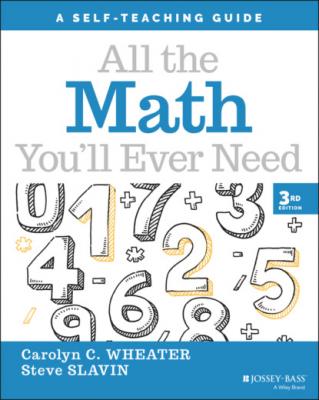All the Math You'll Ever Need. Steve Slavin
Чтение книги онлайн.
Читать онлайн книгу All the Math You'll Ever Need - Steve Slavin страница 10
 StartLayout 1st Row Blank 2nd Row StartLayout 1st Row 95 2nd Row ModifyingBelow times 78 With ̲ EndLayout 3rd Row 760 4th Row 0 5th Row Blank EndLayout StartLayout 1st Row StartLayout 1st Row 9 Overscript 3 Endscripts 5 2nd Row ModifyingBelow times 78 With ̲ EndLayout 2nd Row 760 3rd Row 50 4th Row Blank EndLayout StartLayout 1st Row StartLayout 1st Row 9 Overscript 3 Endscripts 5 2nd Row ModifyingBelow times 78 With ̲ EndLayout 2nd Row 760 3rd Row ModifyingBelow 6650 With ̲ 4th Row 7410 EndLayout"/>
StartLayout 1st Row Blank 2nd Row StartLayout 1st Row 95 2nd Row ModifyingBelow times 78 With ̲ EndLayout 3rd Row 760 4th Row 0 5th Row Blank EndLayout StartLayout 1st Row StartLayout 1st Row 9 Overscript 3 Endscripts 5 2nd Row ModifyingBelow times 78 With ̲ EndLayout 2nd Row 760 3rd Row 50 4th Row Blank EndLayout StartLayout 1st Row StartLayout 1st Row 9 Overscript 3 Endscripts 5 2nd Row ModifyingBelow times 78 With ̲ EndLayout 2nd Row 760 3rd Row ModifyingBelow 6650 With ̲ 4th Row 7410 EndLayout"/>
As you can see, a long multiplication problem can be broken down into a series of simple multiplication problems. It's important to have basic multiplication facts in memory, so you don't have to spend time doing the repeated addition every time. You'll learn more about that in the next chapter.
Problem 1:
Multiply 73 by 5.
Solution:
Begin with 5 × 3 = 15. Put down the 5 and carry 1. Then 5 × 7 is 35 plus the 1 you carried is 36.
Problem 2:
Find the product of 86 and 12.
Solution:
First multiply 86 by 2.
Multiplying 2 × 6 gives you 12, so put down the 2 and carry 1. Then 2 × 8 is 16 plus 1 you carried is 17.
Place a zero at the end of the second line, or if you prefer, just move one space right, and multiply 1 × 86, which obviously is 86. Add the columns to complete the job.
Problem 3:
What is the result when 125 is multiplied by 32?
Solution:
Multiplying 125 by 2 requires a little bit of carrying.
Place a zero on the second line, or move one space right, then multiply 3 × 125. Add down each column, regrouping where necessary.
Ready to test yourself? Try Self-Test 2.1.
SELF-TEST 2.1
1 Add 453 and 975.
2 Find the sum of 1,864 and 798.
3 Multiply 561 by 92.
4 What is the product of 891 and 30?
5 Multiply 135 × 112.
If the first two gave you trouble, review Frame 1. If you got any of the last three wrong, review Frame 2. If you've got this, move on!
3 SUBTRACTION
Subtraction is the inverse, or opposite, of addition. Addition puts together. Subtraction takes apart. If you buy a carton of 12 eggs and you use 4 of them to make breakfast, how many eggs are left? 12 – 4 = 8 if you count the remaining eggs. That subtraction problem is another way of thinking about the addition problem 4 + 8 = 12. Each subtraction problem has a related addition problem. 17 – 9 = ? is related to 9 + what = 17? Sometimes it's easier to think about the addition version. If you have 9 and you want 17, you need 1 to make 10 and then 7 more to get up to 17. That's a total of 8.
For larger problems, you'll work column by column, starting from the ones, just like addition, but sometimes you'll need to “borrow,” which means you'll regroup but in the other direction.
In the following example, the ones column is easy: 8 – 3 = 5. But trying to take 9 away from 3 in the tens column is a problem. If you only have 3, how can you take away 9? (There's more than one answer to that question. We'll look at one now and another one in Chapter 6, “Positive and Negative Numbers.”)
We only have 3 tens in our tens column, and we need more, so we're going to borrow 1 hundred from the hundreds column and exchange it for 10 tens. There are 6 hundreds, so if we borrow 1, there will be 5 left. We'll exchange the 1 hundred for 10 tens and add them to our 3 tens so we have 13 tens. We can subtract 9 tens from 13 tens and get 4 tens, then subtract 1 hundred from the remaining 5 hundreds to get 4 hundreds.
Problem 1:
Subtract 124 from 896.
Solution:
This subtraction doesn't require any regrouping. Just subtract the digits in each column: 6 – 4 = 2, 9 – 2 = 7, and 8 – 1 = 7.
Problem 2:
Find the difference between 293 and 581.
Solution:
To begin, you need to “borrow” and regroup, because you can't subtract 3 from 1. Remember that the 8 tens become 7 tens and the ten we borrowed is added to the 1. Subtract 3 from 11 to get 8.